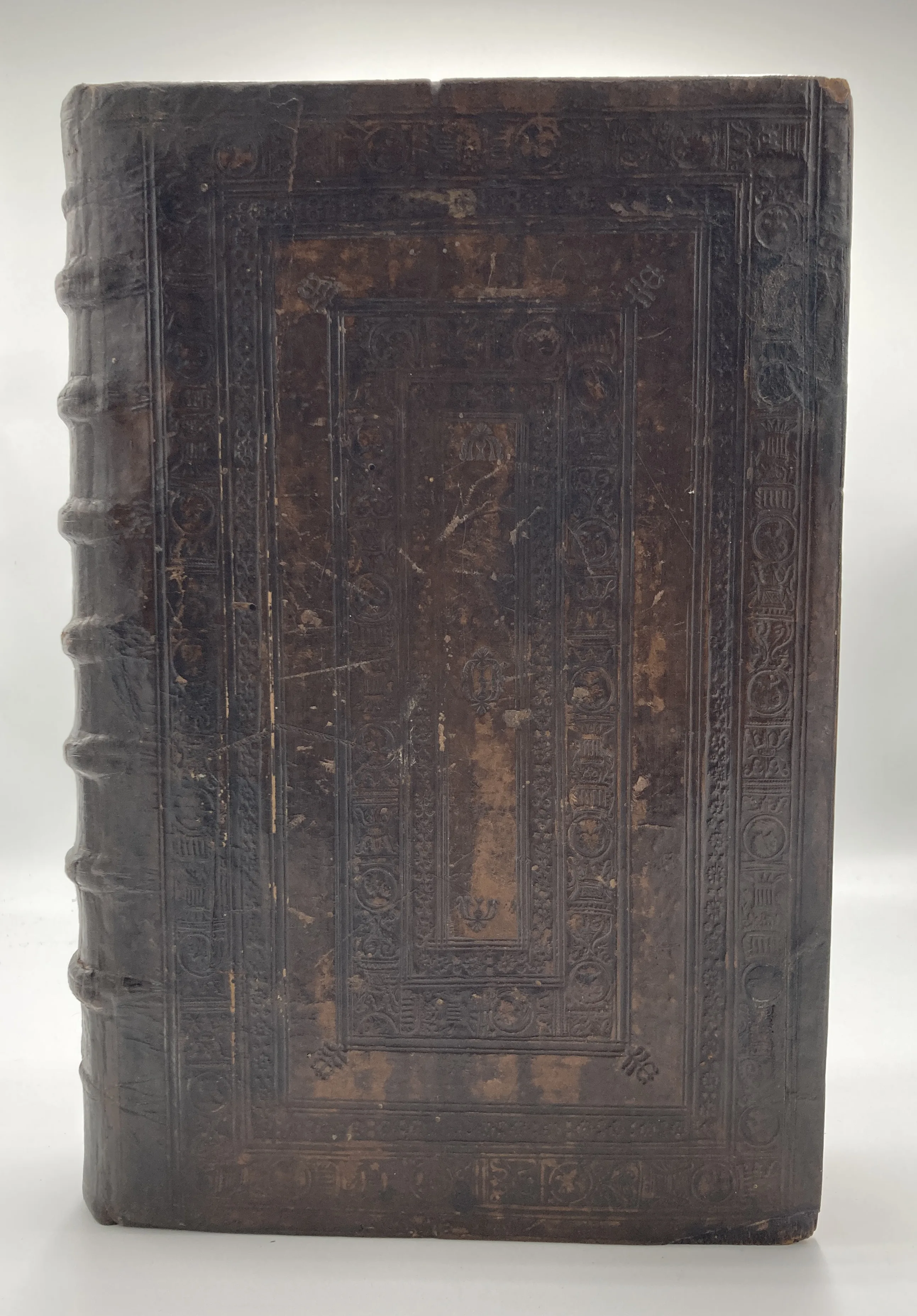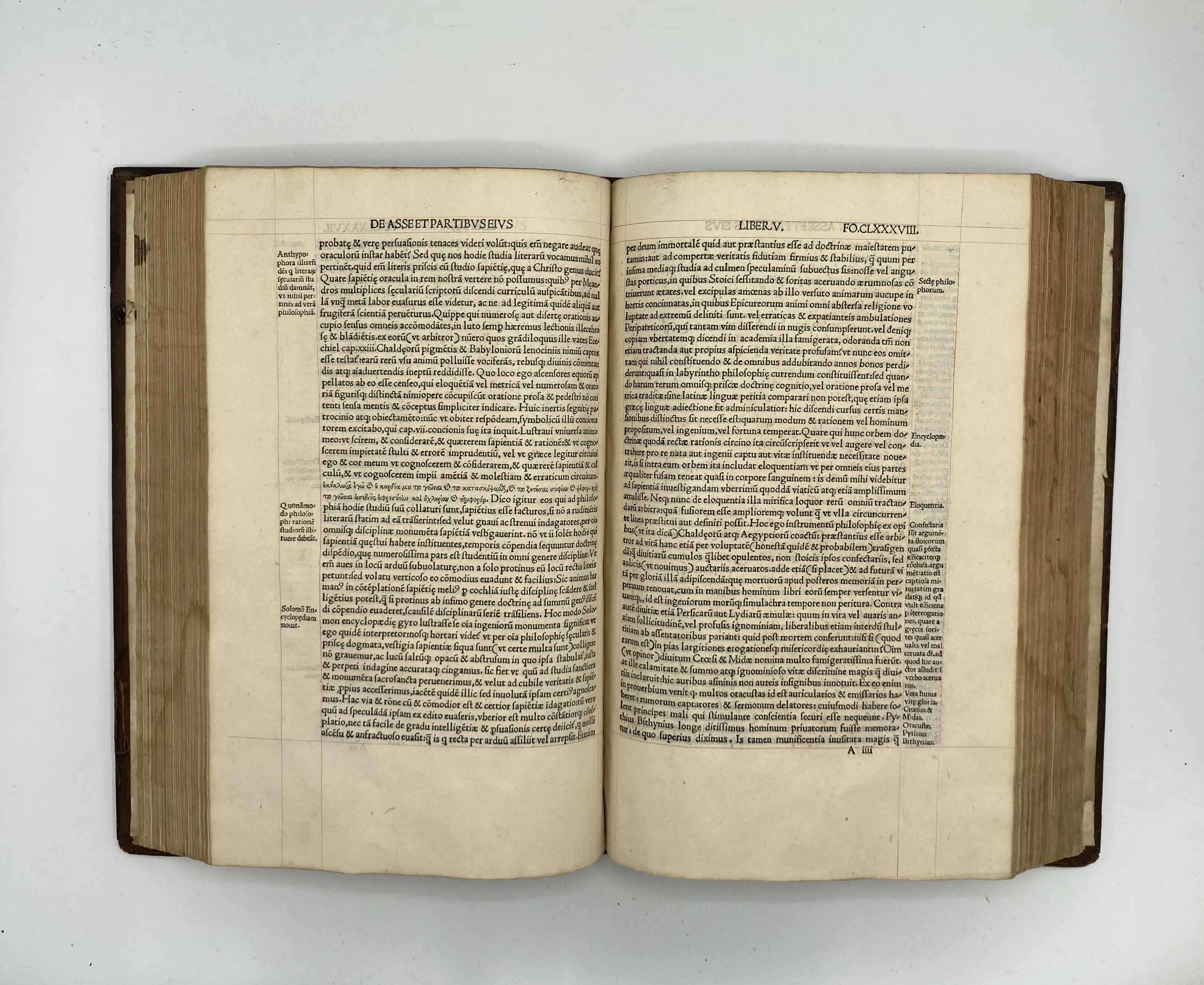BUDÉ, Guillaume.
ATTRACTIVE CONTEMPORARY BINDING
De asse et partibus eius Libri quinque. [with] Annotationes in XXIV Pandectarum libros.
Paris, J. Bade, 1527.£2,950.00
Folio. I: ff. [8], 208, [2]; II: ff. [10], 70. Roman letter, occasional Greek, text double ruled in red. Title in red and black with splendid printing press woodcut within architectural border, decorated initials and ornaments. Few ll. slightly yellowed, minor light water stain at (mostly) blank head or foot of final ll., two tiny mainly interlinear worm holes to final gatherings, the odd ink mark. Very good copies in contemporary French calf over wooden boards, lacking clasps, double blind ruled to a panel design, alternating borders with blind roll of heads within roundels, half columns and tendrils, and blind roll of rosettes and stars, blind-stamped flower sprays to inner corners, another four, of different shape, blind-stamped to central panel, two forming centrepiece, raised bands, ancient repairs to covers by employing waste leather from contemporary bindings decorated in blind, later repair to upper joint, and head and foot of spine. Later ms ‘veu entier’, contemporary ‘Ex libris Sulpitij Charlemaigne’ (overwritten) and two words crossed out, ‘Longelle’(?) and ‘Quod sibi vix multi multo paperere labore uno Budaeus comparat asse sibi’ to front pastedown. Near contemporary ms ‘Sulpitius Charlemaigne’, later ‘Butard’(?) and C17 bibliographical notes to first title. Contemporary ms price 1 [livres] 12 [sous], early ms note on Terence and ‘Laval advocat du Roy au baillage et siege Presidial de senlis Bailly 1591’, ms ‘an[n]o 1529 de 15o octobr[is]’, contemporary ms ‘Emptus 38 (?)’ and erased ex-libris, crossed-out contemporary ms ex-libris, early price ‘4 [livres] 0’ and ‘16 [livres] par mo[n] connetable anglois’ all to rear eps. The odd early ms marginal note.
The fine blind roll of stars and rosettes, and its numerous variations, appear on bindings realised in central France in the first half of the C16 (Gid, ‘Catalogue des reliures françaises’, II, pls 64-66, and I, 136, 166-183). The C16 provenance is from Pas-de-Calais. The earliest purchase notes date to 1529. Sulpice Charlemagne (1527-85) was a Catholic lawyer in Boulogne, later Sieur de la Motte de Macquinghen, near Calais. A later C16 owner was bailiff in Senlis, the centre of numerous local jurisdictions. At least 3 prices for the book were noted during the C16; a C16 owner also noted instructions to their binder on the front pastedown.
Very good copies of these major textbooks on ancient Roman numismatics and civil law, handsomely printed by Ascensius by the French humanist Guillaume Budé (1467-1540). He was one of the founders of the Collège de France and royal librarian at Fontainebleau. First published in 1514, ‘De asse et partibus eius’ is the first work devoted entirely to ancient coins and units of measure, ‘as’ being originally one Roman ‘pound’ of copper or bronze. An encyclopaedia of ancient economic life, it decided Budé’s fame for a ‘key discovery which helped to unlock the ancient system of weights and measures: namely that ancient writers regularly omitted the multiplier “centena millia” from figures such as “decies centena millia sestertium”’ (MacDonald, p.18). The work begins with the most detailed survey of the etymology of ‘as’, the materials it was made of, and its relation to ‘libra’ as weight, followed by a survey of units of measure for land, including an explanation of ‘decussare’ (divide crosswise), a method of dividing land mentioned by Pliny, Columella and Vitruvius, the division of ‘feet’, and the meaning of ‘iugerum’. Most of the remainder is a numismatic tour-de-force, as Budé discusses dozens of types of ancient coinage, e.g., ‘nummulus’, ‘libella’, ‘sestertius’, ‘drachma’, ‘denarius’, etc., with their relative values (‘aestimatio’). ‘In “De asse”, Budé collected and analyzed all kinds of classical economic data, and sought to establish their values in contemporary French money by comparing weights of precious metals with what they could buy in each period. In this way he established the prices, for example, of Alexander’s horse, […] Solomon’s temple, and […] of a loaf of bread’ (McNeil, pp.26-7). There are also long sections on the measurement of weight, length and volume.
First published in 1508, ‘Annotationes’ – ‘the most important and influential work of jurisprudence in the early C16’ (Haas, p.36) – is a commentary on the first 24 books of Justinian’s ‘Pandecta’, also known as ‘Digesta’, the second part of the ‘Corpus iuris civilis’. Devoted to non-statutory (or common) law, it was based on writings and opinions by the renowned jurists Ulpian and Julius Paulus. ‘Budé advocated the methodological principle that Roman law could only be understood and rightly interpreted by a thorough knowledge of classical philology and literature, Roman history and classical literature’ (Haas, p.36). This included the sound assessment of sources and the etymological understanding of terms, which Budé enhanced through long digressions based on ancient authorities. In particular, Budé sought to unearth the original meaning of the ‘Pandecta’ by then inextricably entangled with influential medieval glosses and commentaries.
I: USTC 145830; Moreau III 1153; Pettegree & Walsby 59365. II: No copies recorded in the US. USTC 145820; Moreau III 1152; Pettegree & Walsby 59364. K. MacDonald, Biography in Early Modern France, 1540-1630 (2007); D. McNeil, Guillaume Budé and Humanism in the Reign of Francis I (1975); G. Haas, The Concept of Equity in Calvin’s Ethics (1997).In stock





